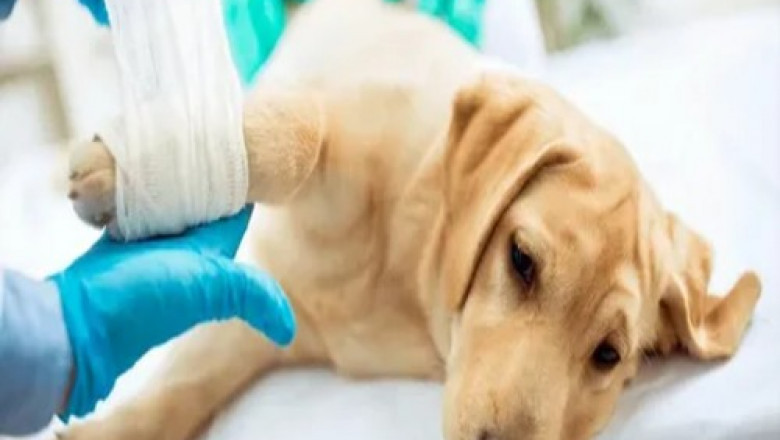views
Causes of Orthopedic Issues in Pets
Many factors can contribute to orthopedic problems in dogs and cats. Genetics play a large role, as certain breeds are predisposed to certain conditions. For example, German Shepherds and Labradors commonly suffer from hip dysplasia, while Lhasa Apsos are prone to intervertebral disc disease. Obesity is another major risk factor that can put extra stress on joints and bones. Trauma from accidents or injuries, like fractures, torn ligaments, or dislocated joints, are also common causes of orthopedic cases. Simply aging and wear-and-tear over time take their toll on the musculoskeletal system as well. Arthritis that develops with advanced age is a frequent orthopedic issue seen in older pets.
Diagnosing Orthopedic Conditions
Veterinary Orthopedics an owner notices limping, lameness, difficulty jumping or climbing stairs, reluctance to exercise, or pain/discomfort in their pet, it's important to schedule an exam with their veterinarian. The vet will gather information about the case history and perform a physical examination, feeling joints and range of motion. Depending on findings, they may order diagnostic imaging tests like X-rays, CT scans, or MRIs to evaluate the bone and soft tissues. Advanced imaging allows precise evaluation of the location and severity of issues like fractures, luxations, bone infections, disk problems, and arthritis. Labwork is also done to rule out systemic diseases or infections that could manifest with orthopedic signs. Once a diagnosis is made, treatment options can be discussed.
Surgical Orthopedic Procedures
Many orthopedic conditions require surgical intervention for definitive treatment and pain management. Common procedures include arthrotomies to explore joints, remove debris, repair torn ligaments or cartilage, reattached torn muscles/tendons, or replace diseased joints with prosthetics like total hip replacements. Fracture repair with plates, screws, pins etc. provides stabilization for broken bones to heal properly. Luxation/dislocation reductions manipulate joints back into their normal anatomical position. Bone infections are treated with lavage and debridement to clean out infected tissues. Spinal surgery like diskectomy or spinal fusion helps relieve pressure on nerves from herniated disks or spinal instability. Careful pre-surgical planning and surgical skill are crucial to achieving good functional outcomes with orthopedic surgeries.
Conservative and Alternative Orthopedic Therapies
While surgery addresses some severe structural orthopedic issues, other conditions can be managed more conservatively. Weight loss for overweight pets reduces load on weight-bearing joints. Physical rehabilitation through controlled exercise, massage, underwater treadmill therapy, and laser therapy increases mobility and muscle mass while decreasing pain and stiffness. Joint supplements containing glucosamine, chondroitin, and nutrients like manganese, vitamin C support natural joint health and lubrication. Prescription anti-inflammatory medications, disease-modifying osteoarthritis drugs, or injections of corticosteroids into joints provide relief from arthritis pain and inflammation. Alternative therapies like acupuncture, chiropractic techniques, and therapies address pain and comfort from a holistic perspective. Owners play a supportive role by providing assistive devices, modifying activity levels, and maintaining consistent treatment plans.
Common Orthopedic Conditions in Dogs
Hip dysplasia remains one of the most prevalent orthopedic diseases affecting large and giant breed dogs. The malformed hip joint causes lameness, pain, and arthritis. Cruciate ligament tears from the stifle joint are a common soft tissue injury, often requiring surgery. Elbow dysplasia refers to malformations in the elbow joint leading to arthritis. Growth plate injuries are seen in large, fast-growing puppies. Osteosarcoma is a common orthopedic cancer found in older, large breed dogs. Intervertebral disc disease can cause leg paralysis from herniated discs pressing on the spinal cord. Arthritis becomes more frequent with aging and affects many dogs by 7-10 years of age.
Common Orthopedic Conditions in Cats
Hip dysplasia rarely occurs in cats, but osteoarthritis of weight-bearing joints is common. Injuries from trauma are fairly frequent. Intervertebral disc disease is a notable cause of back pain and rear leg weakness in cats. As with dogs, arthritis becomes increasingly prevalent with age. In certain breeds, patellar luxation, where the knee cap slips out of place, can develop. Toe nail fractures from aggressive scratching at scratching posts also present orthopedic challenges. Panosteitis, an inflammation of long bones like the femur, causes transient lameness in young cats between 5-14 months old. With early detection and treatment, most orthopedic conditions in cats can be effectively managed.
Improving Outcomes with Proper Care
Dedicated owners play a vital supportive role in their pet's orthopedic healthcare plan. Compliance with weight control plans, medication schedules, physical therapy, restricted activity during healing as instructed by the veterinarian is essential. Regular vet visits allow monitoring of progress for adjustments to treatment if needed. Catching issues early before they become advanced or require surgery optimizes outcomes. Gentle exercise, warm compression, massage therapies, assistive devices, and a comfortable sleeping area aid recovery. With a multidisciplinary team approach between owners, veterinarians, surgeons, rehabilitation specialists, and alternative practitioners, many orthopedic cases can see resolution of clinical signs and improved quality of life.
About Author:
Money Singh is a seasoned content writer with over four years of experience in the market research sector. Her expertise spans various industries, including food and beverages, biotechnology, chemical and materials, defense and aerospace, consumer goods, etc. (https://www.linkedin.com/in/money-singh-590844163)






















Comments
0 comment